Legends
home
A Cool Tradition. A Dream of Champions. Legends of Australian Ice.
Organised ice hockey has been played in Australia for over a CENTURY.
In fact, the ice hockey tradition here is so richly steeped in EMINENCE,
The booming years of MARVELLOUS MELBOURNE,
And the earliest EMERGENCE of the sport internationally,
One wonders how on earth its STORY
Was ever able to be LOST for one whole century,
Like DUST between the cracks of history.
[ HOCKEY ] Newtown Tart
Ettie Wallach (1886 - 1963)
![]() Not suprisingly perhaps, the reaction of male students to early expressions of female athleticism was often patronising, or even derisive. Jocular references to the women's efforts — such as to the 'erratic volleying' of 'fair contestants' or to 'energetic oarswomen' who managed to return 'without the loss of even an oar' — frequently appeared in the student magazine and as late as 1908 the first women hockey players, forbidden use of the University Oval and banished to a field in Newtown, were dubbed, dismissively, 'Newtown Tarts'.
Not suprisingly perhaps, the reaction of male students to early expressions of female athleticism was often patronising, or even derisive. Jocular references to the women's efforts — such as to the 'erratic volleying' of 'fair contestants' or to 'energetic oarswomen' who managed to return 'without the loss of even an oar' — frequently appeared in the student magazine and as late as 1908 the first women hockey players, forbidden use of the University Oval and banished to a field in Newtown, were dubbed, dismissively, 'Newtown Tarts'.
— Sonja Lilienthal [13]
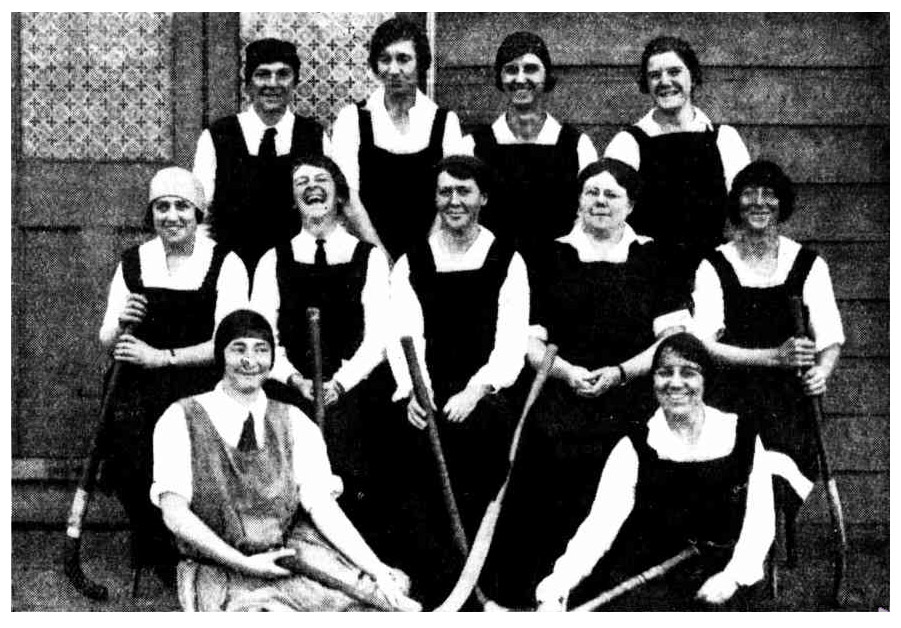
Ettie Wallach [on right of middle row] and the TTC Graduate's Team, winners of the hockey match against the Teachers' Training College, 20 June 1923. Back row (left to right): Misses C Wilson, M Harrington, R Hirst, M Tarrant. Middle Row: Misses S Mackay, L Houison, N Griffin, T Meares, E Wallach. In Front: Misses B. Harper and M. Sherwin. [30]
 HE LADY WAS A NEWTOWN TART. She went to Sydney uni, she hung out in slummy Newtown, and she "played boys' games in skirts that were shortened to six inches above the ground". [6, 13] She was among the Sydney Uni students who played a mixed field hockey match every week by 1907, but not on the campus, because the University did not approve of girls like that. [13] They were banished to a field in Newtown. She played right inside for the Cooeyanna Hockey Club (1907-1915), [2] and she may even have been a player on the first Sydney University Women's team in 1908, captained and coached by feminist, Jessie Mary Lillingston Street (1889-1970). Now, that particular "Newtown Tart" came to be recognised worldwide as a peace activist, and the only woman on the Australian delegation to the founding conference of the United Nations in 1945.
HE LADY WAS A NEWTOWN TART. She went to Sydney uni, she hung out in slummy Newtown, and she "played boys' games in skirts that were shortened to six inches above the ground". [6, 13] She was among the Sydney Uni students who played a mixed field hockey match every week by 1907, but not on the campus, because the University did not approve of girls like that. [13] They were banished to a field in Newtown. She played right inside for the Cooeyanna Hockey Club (1907-1915), [2] and she may even have been a player on the first Sydney University Women's team in 1908, captained and coached by feminist, Jessie Mary Lillingston Street (1889-1970). Now, that particular "Newtown Tart" came to be recognised worldwide as a peace activist, and the only woman on the Australian delegation to the founding conference of the United Nations in 1945.
Ettie Wallach was a first-year Arts student at the University of Sydney in 1905, [5] and Honorary Treasurer of the Dramatic Society in 1908, the year Jesse Street enrolled in the same degree course and coached the university's first ladies' hockey team. Wallach's Cooeyanna was one of six foundation clubs of the NSW Ladies' Hockey Association in 1907, and in 1910 they defeated Sydney University, 8-2; Wallach and Street both scoring for their respective clubs. Cooeyanna did it again in 1911, and so on, becoming the strongest women's team of the State hockey association by 1913, and probably earlier. [25]
In 1914, when Wallach was 28 years-old, she represented New South Wales on the right wing against the touring English XI field hockey team at Rushcutters Bay. [2, 3] She scored against England, [4] in the interstate tournament in which the tourists were not contestants for final honours. The English XI also played the Hockeyroos that year in their first ever international, and at least one newspaper expected Wallach to be selected. [28] Ettie was a committee-member of the Women's Hockey Association in 1915, her club's last season, when the effects of the war and the consequent general depression really began to bite. [28]
A foundation player of the first New South Wales Ladies' Ice Hockey Club, Wallach represented her State in Gower Cup ice hockey in 1922, 1924, 1925, 1926, 1928, and quite possibly the years in-between. Like the earlier men's interstate tournament, the Goodall Cup, the first women's interstate tournament was a best-of-three series contested by New South Wales and Victoria. In those years, there was no local women's club competition, the local Ladies' Ice Hockey Club instead splitting into teams, Whites versus Greens. Wallach was best player for Whites in 1924, with Mirey Reid in net. [27]
Henrietta Wallach was born in 1886, [8] one of eleven children of Henry Wallach (c1837-1917) and Mary Ann Carelton of 31 Ocean Street, Bondi. Her father had emigrated to Australia from Hamburg in Germany with his father, Adolph (1786-1884). [9] Ettie and her sisters Florence and Stella attended Sydney Church of England Girls Grammar School, now SCEGGS Darlinghurst, where she was awarded numerous prizes for general proficiency and passed the Junior Public Examinations of the University of Sydney with two A's, three B's and a C. [10] She graduated from Sydney University with an Arts Degree and a passion for hockey on both mud and ice that lasted over two decades. She then graduated from Sydney Teacher's College in the University grounds, where she also played hockey, even as a thirty-six year-old graduate in 1923. [30]
Perhaps then it should come as no surprise to discover that she was from a celebrated sporting family, an Eastern Suburbs surfing dynasty, [16] with eight brothers evenly spread between Bondi and Maroubra surf clubs. Her younger sister, Stella, also played field hockey for Cooeyanna HC and represented New South Wales between 1910 and 1914. [26] Her niece, Muriel Florence Wallach, the daughter of her brother Bernard, also played Gower Cup ice hockey for New South Wales. Two brothers, Clarrie and Neville, were rugby union players and decorated Anzacs.
Clarrie, "Doss" to his mates, played lock for Sydney Grammar School and Eastern Suburbs RUFC where he was lock number eight between 1910 and 1914. He was the heaviest and tallest member of the Waratahs when he first played in 1913. He represented New South Wales at least eight times, and Australia five times, in a brilliant career that was cut terribly short by war. His test debut for the Wallabies was New Zealand versus Australia at Wellington that commenced on September 6th 1913, [14] and "it was agreed by friend and foe alike that he was one of the outstanding Australian players of the year". [23]
Her brother Neville also played with Eastern Suburbs RUFC and was an active member of the Bondi Surf Bathers' Life Saving Club founded in 1903, and officially recognised as the oldest surf lifesaving club in the world. He was the first of the brothers to enlist at the age of eighteen as reinforcements in the 13th Battalion. After the withdrawal from Gallipoli, he was reunited in France with his brother Rupert who had just been assigned to the Battalion. Neville fought through 1917, rising to the rank of Captain while still only twenty-one years-old. He was twice wounded and mentioned in despatches. In September 1917, he was awarded the Military Cross for 'consistent good work', [12] with a citation that read:
'He was a Platoon Commander in the attack on the Hindenburg Line near Bullecourt on the 11th April, 1917 and though he received a bullet through his thigh within one minute of zero, he led his men over 1200 yards of ground swept by shell and machine gun fire ... Captain Wallach is a very capable officer and bears a high reputation for bravery'.
Doss left for war as a private in 1916 and joined the attack on Hill 60, where Cyril Lane was fighting and eventually killed. Lane was the New South Wales ice hockey team's first netminder. Doss "went right through Gallipoli without a scratch", and then on to France. Soon after, he was promoted to Captain, named in despatches, and awarded the Military Cross "for conspicuous gallantry during operations under a very heavy bombardment, which lasted 48 hours. After his company commander had been killed and the company had suffered severely, he took command and steadied the men by his fine example and cool courage." His good luck ran out near Villers-Bretonneux.
On a cold and rainy April 7th 1918, one man in four was hit as Doss once again led his company across 400 yards of open ground during a German attack on Hangard Wood, The Somme. Machine gun fire wounded him in both knees, compound fracturing his left leg. [17] Gas gangrene set in and doctors amputated the limb, but his temperature soared and, in a desperate attempt to save his life, the other leg had to come off too. [1]
The shock was too great and he weakened and died on April 22nd, aged twenty-eight. His war diary describes fighting alongside Gurkhas and details of action at Gallipoli, mostly at Pope's Post. He recorded the evacuation and the fear of a party of one hundred Turkish soldiers advancing from Malone's Gully. Doss was part of the rear-guard action covering the withdrawal and was amongst the last men to leave the beach. [15]
"I shall never forget passing the graves of our boys who had fallen", he wrote, "we just looked at each other, but no-one spoke, some were too exhausted and some on account of their feelings. On our arrival at the beach we embarked on a punt and were soon on our way out to the transport, taking a long, last look at a Gallipoli. We had only got a few hundred yards out when they blew up the mines on Russell’s Top, done by the last party to leave, they then pushed off in a launch and Gallipoli so far as ANZAC and Suvla were concerned was once more all Turkey’s." [15]
About a week later, on May 1st 1918, Ettie's brother Neville was killed when a shell burst at his company headquarters, sending a splinter through his head as the officers were sitting down to tea. He was just twenty-one years-old. Three of her remaining six brothers also served. Henry in Hobart enlisted as a private in the 12th Battalion, aged thirty-five. He survived the war and returned a corporal in July 1918. Rupert, who also played for Eastern Suburbs, [24] enlisted at the beginning of the war in August 1914. He saw action in New Guinea, Gallipoli and France in C Company of the Australian Naval + Military Expeditionary Force (Tropical Unit). Arthur enlisted as a Gunner in Machine Gun Company 1 in January 1916, left Sydney that May and returned home in August 1918.
Of the five rugby-playing Wallach brothers, two were killed, Arthur was wounded, Henry was shell-shocked and Rupert was taken prisoner in Germany. By the time the ANZAC forces finally evacuated Gallipoli, seven Wallabies had been buried on the Dardanelles Peninsula. Doss was one of one hundred and forty international rugby players from nine countries who died in the war. [1]
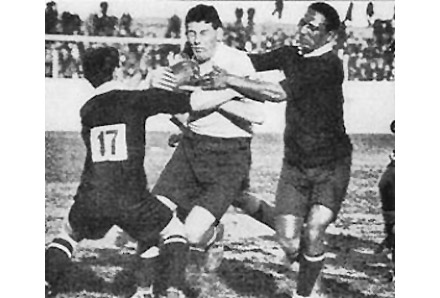
Doss Wallach for the Wallabies, New Zealand v Australia at Wellington, 1913
In 1919, a grateful Mother Country hosted a rugby tournament: seven teams at eight venues, playing seventeen matches to declare a first "world champion." There had never been an international team tournament like it. For the first time, teams from Australia, Canada, New Zealand, South Africa, Britain, and France were assembled in one place. [17] Rugby held the first ever "World Cup" and in 2015 the tournament returned to England as the world remembered the Centenary of the Great War.
When the new clubhouse of the Maroubra Surf Life Saving Club opened in 1933, tablets were unveiled in memory of three former members and pioneers of surfing on the beach, one of whom was Wallach's brother, Doss. [19] The following year, the club unveiled an honour roll in memory of ten members who were killed in action, including her brothers, Doss and Neville. [18]
One evening in August 1924, the long table in the Blue Room of the Maclurcan's Wentworth Hotel in Sydney was decorated in the navy and white colours of the New South Wales Ladies' Ice Hockey Club. Ettie Wallach and the country's best women ice hockey players sat down to dinner around it, two rival State clubs, two or three weeks after the third Gower Cup had been won in Melbourne by New South Wales. Wallach was thirty-eight years-old. A decade had flown by since she first represented her State against England in field hockey, and seventeen years since she had first taken it up.
The New South ladies were captain Annie Baker Ford, future captain Jessie Hall, Nancy Kerr, Goulet, R Lauder, Roth, Duff, Mirey Reid, Enally, goalie Ida Waite, Keir, Elsie Rea, Morton, Thomas, Saemens and Croll. The Victorians were captain Madge Kendall, former captain Keira Gower, Winnie Williams, Maffie Molony, A Wilson, goalie Dina Callaway, and Marea Lucas. [20] In just three seasons, The Argus newspaper in Melbourne was able to write of the 1924 Gower Cup, "the women of both teams displayed a vast knowledge of the finer points of the game, and provided one of the finest women's matches ever witnessed at the Glaciarium".
Ettie Wallach was a pioneer of women's hockey in Australia, both on the field and on the ice. She represented New South Wales in the Gower Cup from its inception in 1922, until it ended abruptly in the Great Depression. She died unmarried in Sydney in 1963 at the age of 77, the same year as her sister, Stella, and brother, Arthur. [8]
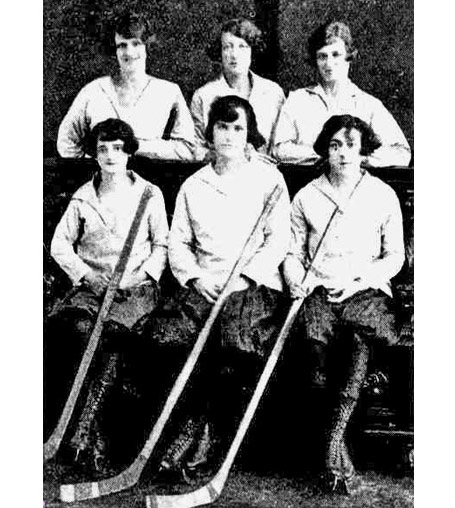
Ettie [centre of back row] and the New South Wales Ice Hockey Team, 1925 Gower Cup Champions. Back row (left to right): Annie Baker Ford, Ettie Wallach, Elsie Rae. Front: Ida Waite, J Hall (Capt), Nancy Kerr. [29]
![]()
Parts of this story are from the biography of Ettie Wallach soon to be added to the Women's Hockey section of the website. [31]
Image [slideshow above]: Women's Hockey at Manly Oval, 1905 [31]
The First NSW Captain: Norman Ducker
Seven Miles from Sydney: Annie Baker Ford
The First NSW Goalie: Cyril Lane

Sydney University Teams, 1908, National Library Australia. Jessie Street (coach of the women) is in the second row, on the left. [6]
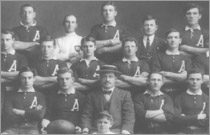
Doss Wallach [4th row standing 3rd from left] with the Australian Rugby Team, 1914 [24]
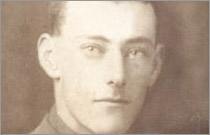
Neville, Portrait at the Bondi Surf Bathers Life Saving Club, Image courtesy Digital Masters Australasia
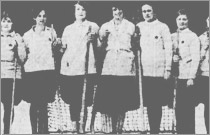
Ettie [4th from left] with the New South Wales Ladies' Ice Hockey Team, 1928
Citations:
[1] Into Touch: Rugby Internationals Killed in the Great War, Nigel McCrery
[2] Sydney Morning Herald, 11 July 1914, p 23, Women's Hockey Interstate Carnival
[3] Sydney Mail, NSW, 19 August 1925, p 20
[4] Referee, Sydney, 22 July 1914, p 9
[5] Sydney Morning Herald, 17 March 1905, p 7
[6] Origins of Hockey in Sydney and of our Club: A 2013 Perspective, Sydney University Hockey Club, 2013
[7] Heather Radi, 'Street, Jessie Mary (1889–1970)', Australian Dictionary of Biography, National Centre of Biography, Australian National University, accessed online 8 August 2015.
[8] NSW Registry of Births, Deaths and Marriages Reg No 242/1886, 17983/1963
[9] Sydney Morning Herald 24 July 1884 Deaths. WALLACH. -May 27, at Hamburg, Adolph Wallach, father of Henry Wallach, of George-street, Sydney, aged 98.
[10] Jewish Herald, Victoria, 15 August 1902, p 4
[11] Sydney Morning Herald, 23 June 1910, p 12
[12] Sydney Morning Herald, 20 May 1918, p 8
[13] Newtown Tarts: A History of the Sydney University Women’s Sports Association 1910-1995, Sonja Lilienthal, 1997, p. 17
[14] Clarrie (Doss) Wallach player profile, espnscrum.com website, online
[15] Clarence (Doss) Wallach war diary, 1915-16, online transcript
[16] The Anzac Story, Bondi Surf Bathers' Life Saving Club
[17] After the Final Whistle: The First Rugby World Cup and The First World War, Stephen Cooper, 2015
[18] Sydney Morning Herald, 22 November 1934, p 6. Memorial to Life-Savers
[19] Sydney Morning Herald, 1 May 1933, p 13. New Club House Opened
[20] Sunday Times 24 August 1924 p 17. At the Wentworth
[21] The Sydney Sun Sep 1918, Bishop Among Diggers, Hospital Visiting, How Brave Men Die by Bishop Long. Syndicated in several Victorian newspapers.
[22] The AIF Project, Peter Dennis, Wallach/ Wallack entries. Online
[23] Wallabies Player Profile, Clarence Wallach, online
[24] Rugby Remembers website online
[25] Glen Innes Examiner, 14 August 1913, p 4
[26] Sydney Morning Herald, 9 June 1913, p 8. Hockey, Ladies' Interstate Matches and 28 June 1911, p 8, Lady Players
[27] Referee, Sydney, 9 July 1924, p 14. Stirring Ice Hockey
[28] Sydney Morning Herald, 28 April 1915, p 6. Hockey, No Competition Games
[29] Barrier Miner, Broken Hill, 21 July 1914, p 2. International Hockey.
[30] Sydney Mail, 20 June 1923, p 32. The Graduate Team, Teacher's Training College
[31] Sydney Mail and New South Wales Advertiser, 19 July 190, p 163
[32] Sydney Mail, 19 August 1925, p 20


